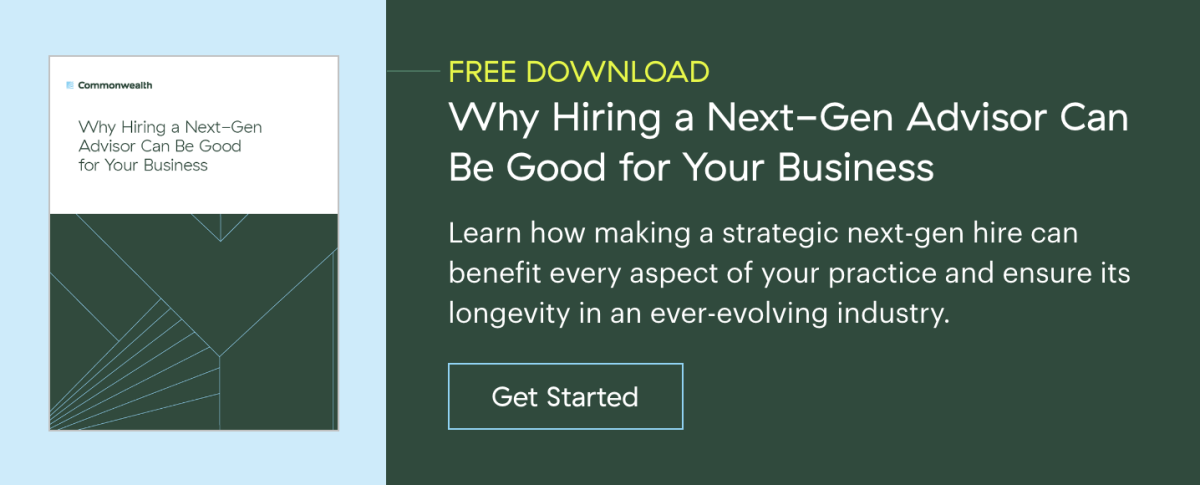What’s the Story?
-
Many advisors think hiring another advisor is the solution for a growing firm, but you may want to consider other options.
-
Just like an ideal client profile, an ideal advisor profile can help ensure you zero in on the right candidate.
-
Asking key questions during the interview process can uncover a prospective advisor’s motivation and compatibility.
-
Next: Building Economies of Scale | Previous: Ready to Grow Your Advisory Business?
Hiring an advisor is similar to acquiring a client: both require you to identify, attract, qualify, interview, close, and assimilate that individual into the practice. While you likely have an ideal client profile that lays out traits (e.g., occupation, net worth, personality) of individuals you most want to work with, I bet you don’t have the same document for advisors you want to work with. If you’re planning to expand, here’s how to create one and use it to recruit the right advisor for your firm.
1) Check Your Assumptions—and Consider Alternatives
Why do you think bringing on an advisor is right for your business, and how will this individual contribute to your firm’s success? Are you looking to hire a next-gen advisor to service clients and become a producer or a midcareer advisor who will bring over their own book? In many cases, bringing in a new advisor can increase your overhead, interfere with your day-to-day with training and supervising, and even create short-term inefficiencies. To be sure you’re making the right decision, consider alternatives based on your goals.
-
“I want a formalized succession plan.” Unless you have firsthand experience with a potential hire and know their work style, service model, and interests, you won’t know if this person is succession material. Instead, contemplate establishing a simple continuity plan with an advisor you know outside your firm. This way, you can protect your clients while you continue to look for your ultimate successor.
-
“I want to be able to share ideas with another advisor.” If that’s all, hiring a new advisor may be overkill. Instead, look for other opportunities to connect with advisors, such as attending local networking or business organization functions and using LinkedIn to find advisors in your area.
-
“I want to be able to share overhead with another professional.” It can be helpful to have another advisor filling a spot to minimize overhead costs, but adding another name to your payroll might not be the best way to go about it. Consider renting your space to a CPA or an attorney—who might also be a referral source.
-
“I want someone to service my C and D clients.” Check the revenue distribution of your C and D clients in relation to your overall revenue. Compare it to the potential salary, overhead costs, mentoring, or training you would provide to this individual. Would these clients be profitable if you made a new hire? If not, it might be best to prune or move them to a lower service tier.
2) Create an Ideal Advisor Profile
Now that you’ve checked your plan, thought about alternatives, and determined that you do need someone in your practice, it’s time to get specific about your ideal advisor. Think about the following attributes:
-
Years of experience or point in career
-
Production and business mix
-
Knowledge, skills, and designations
-
Client service standards and service model
-
Investment philosophy
-
Growth trajectory and business goals
-
Client niche
-
Personality and personal values
Determine the relationship you want to have with this individual. If partnership were on a spectrum, where would you land with adding this new advisor? Would they become a separate entity from your business? Do you want to share clients or only share space? Map your specific interests in interacting with this advisor and be clear on those ideals. This will also dictate whether you will pay this individual a salary or they will derive income from clients.
3) Start Your Candidate Search
There are multiple ways to source for advisors, just as there are for clients. Decide which qualifications your ideal advisor would possess and where you might find a potential match. It could be at industry or networking events, business meetings, or conferences. Other ideas include the following:
-
Referrals: Sourcing for individuals through a professional network is still the gold standard. Alert trusted professionals in your industry that you’re looking for an advisor to join your firm.
-
Search industry directories for connections: If you’re in need of a CFP® practitioner, the CFP Board website has a search tool for local advisors. Looking for someone with experience working with retirement plans? Try Fi360’s designee directory.
-
Industry-specific job boards: You can use the CFP Board, Financial Planning Association, National Association of Personal Financial Advisors, and eFinancialCareers to find qualified candidates.
-
Non-industry job boards, such as Indeed.com and Monster.com, are still common places to post your ad. Consider other locally based job boards that have a good reputation, such as a chamber of commerce.
-
Local colleges with alumni groups and CFP® courses or finance degrees: Some universities offering an advanced degree in financial planning will have a job board.
-
LinkedIn: This is a great resource to connect with former colleagues at other firms and make new connections. You can post a status update of your search or upload the job posting.
-
Use Google: Take advantage of Google’s powerful algorithms by searching for advisors in specific ZIP codes. Connect with these advisors on LinkedIn.
4) Make the Most of the Interview Process
Finding ideal candidates is just the beginning. You need to meet with each one and sell your story, all while determining who is a true match. Here’s how to prepare to ensure you recruit the right advisor for your firm:
Review FINRA BrokerCheck. Here, you can view work history, any complaints, or past affiliations.
Create the story. What’s your firm’s value proposition, and why is your practice, or this situation, the right place for this advisor to land?
Understand the “what’s in it for me” factor. Think from the advisor’s point of view—how will this individual benefit from affiliating with your firm? Draft a compelling argument discussing what your firm offers, as well as what you believe are the advisor’s pain points. You could include the following:
-
Your service model
-
Access to a client niche
-
Opportunities to shift to fee-based or financial planning approach
-
Use of technology and systems
-
Systematized client processes or systems within your firm
-
Peace of mind with succession or continuity
-
Collaboration
-
Your office location
-
Experienced staff members
Plan your interview conversation. When you’re meeting with a candidate, be sure to ask the following questions:
-
Why do you want to make a change? And why now? People are motivated to find a new situation for many reasons, and it’s important to know what these reasons are.
-
What are your goals? Will this position satisfy the individual’s career goals? How?
-
How do you acquire clients? If you are expecting growth, it makes sense to learn about this advisor’s achievements and prospecting experience.
-
What are your expectations? Whether you’re looking to fill the spot in your office with another advisor but remain separate entities, or you want to build a business together, ensure that that’s what the other party is interested in as well.
5) Avoid Common Pitfalls
Beware forcing a round peg into a square hole. While meeting with potential advisors, hold strong to your vision. Successful advisors are skilled at persuasion and at selling themselves, so stick to your ideal advisor profile and don’t let yourself be charmed by an individual who isn’t a good match. Hiring mistakes can usually be traced back to an initial misalignment of goals or expectations.
Avoid making concessions or believing someone will change to meet your vision. Unwinding an advisor relationship can be costly and time consuming, so focus on what the advisor brings to the relationship in their current state—not what you see as potential.
Don’t rush a decision. Hiring an advisor is a long process, particularly in a low unemployment environment. It’s best to take time off from recruiting, or find alternative ways to address your challenges, rather than make a hiring decision that could damage your practice in the long run. Stick to your image of the ideal advisor, and eventually the right one will come along.
What to read next:
If your firm has surpassed $1 million in revenue per lead advisor, take these next steps to scale your practice.
For meaningful practice growth, start with these 10 sustainable marketing strategies.
Editor’s note: This post was originally published in June 2019, but we’ve updated it to bring you more relevant and timely information.



